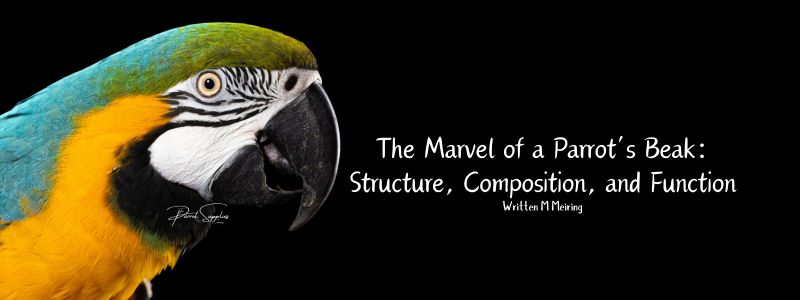The Marvel of a Parrot’s Beak: Structure, Composition, and Function
Parrots, belonging to the order Psittaciformes, are renowned for their vibrant plumage, intelligence, and notably, their distinctive beaks. These beaks are instrumental for feeding and play crucial roles in climbing, grooming, and manipulating objects. Understanding the composition and structure of a parrot's beak offers insights into its functionality and evolutionary adaptations.
Anatomical Structure of the Parrot's Beak
A parrot's beak is a complex organ comprising several integral components:
-
Bony Core: The foundation of the beak is its bony core, primarily formed by the premaxillary bone in the upper mandible and the mandibular bone in the lower mandible. This osseous structure provides the necessary rigidity and strength for various activities, from cracking nuts to intricate manipulations.
-
Rhamphotheca: Encasing the bony core is the rhamphotheca, a keratinized sheath that serves as the beak's outer layer. This sheath is composed of multiple layers of keratin, a fibrous structural protein also found in feathers, claws, and scales. The rhamphotheca is dynamic, continuously growing to compensate for the wear resulting from daily activities.
-
Neurovascular Components: Embedded within the beak are intricate networks of blood vessels and nerves. Sensory papillae, rich in nerve endings, extend from the bone into the rhamphotheca, especially towards the beak's tip. These structures endow parrots with a heightened tactile sense, enabling precise manipulation of objects and effective exploration of their environment.
avmajournals.avma.org
Keratin Composition in the Rhamphotheca
The rhamphotheca's resilience and functionality are attributed to its keratin composition. In birds, the beak's outer shell consists predominantly of beta-keratin, a protein that imparts hardness and durability. Beta-keratin molecules are arranged into stacked beta-sheet structures, conferring mechanical strength essential for various beak functions.
en.wikipedia.org
Studies analyzing the protein composition of avian beaks have revealed a high content of glycine, approximately 30 residues per 100, along with moderate levels of tyrosine and serine. Interestingly, the cystine content is relatively low, ranging from 2-5 residues per 100. This specific amino acid composition contributes to the unique mechanical properties of the beak, balancing hardness with a degree of flexibility. pubmed.ncbi.nlm.nih.gov
Functional Adaptations of the Parrot's Beak
The structural composition of a parrot's beak is a testament to evolutionary adaptations tailored to their ecological niches:
-
Feeding Mechanics: Parrots are predominantly granivorous, feeding on seeds and nuts that require significant force to crack. The robust bony core, combined with the hard keratinized rhamphotheca, allows parrots to exert substantial bite forces. For instance, larger parrot species can produce bite forces comparable to that of a large dog, facilitating access to a variety of food sources.
en.wikipedia.org -
Sensory Perception: The presence of sensory papillae within the beak enhances tactile feedback, enabling parrots to detect textural variations and manipulate objects with precision. This sensory capability is crucial not only for feeding but also for social interactions and environmental exploration.
avmajournals.avma.org -
Continuous Growth and Maintenance: The perpetual growth of the rhamphotheca ensures that the beak remains functional despite constant use. Activities such as feeding, preening, and gnawing naturally wear down the beak, and the continuous growth compensates for this attrition, maintaining optimal length and functionality.
frontiersin.org
Clinical Considerations
Understanding the beak's anatomy is paramount in avian veterinary medicine:
-
Beak Trimming: In captivity, parrots may not engage in sufficient activities to naturally wear down their beaks, leading to overgrowth. However, improper trimming can damage the sensitive neurovascular structures within the beak. Research recommends that, particularly in species like the grey parrot, the upper and lower beak should not be trimmed closer than 8 to 10 mm from the underlying bone to prevent injury.
avmajournals.avma.org -
Beak Abnormalities: Conditions such as avian keratin disorder (AKD) result in abnormal keratin growth, leading to overgrown or misshapen beaks. This can impede a parrot's ability to feed, preen, or engage in normal behaviors. Early detection and intervention are crucial to manage such conditions effectively. stevecreek.com
Conclusion
The parrot's beak is a marvel of evolutionary engineering, intricately designed to fulfill multiple roles from feeding to social interaction. Its composite structure, combining a sturdy bony foundation with a dynamic keratinized sheath enriched with sensory capabilities, exemplifies nature's ability to tailor anatomical features to an organism's ecological and behavioral needs. Ongoing research into the nuances of beak composition and function not only enhances our understanding of avian biology but also informs better practices in the care and conservation of these remarkable birds.
References:
~ https://en.wikipedia.org/wiki/Beta-keratin
~ https://avmajournals.avma.org/view/journals/ajvr/84/7/ajvr.23.03.0059.xml?ut
~ https://en.wikipedia.org/wiki/Parrot
~ https://pubmed.ncbi.nlm.nih.gov/1023860/

